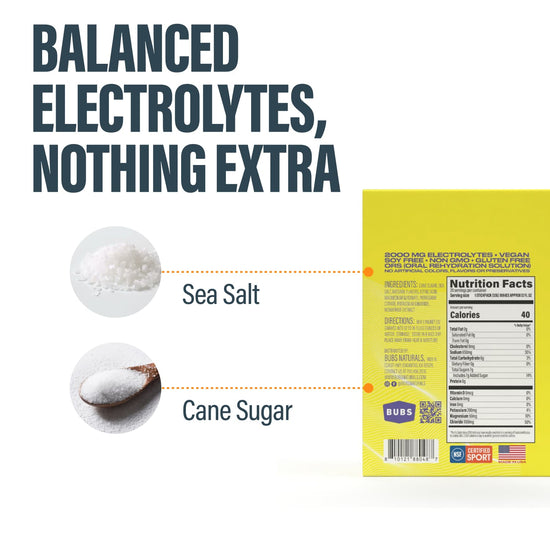Table of Contents
- Introduction
- The Science of Electrolytes
- Identifying the Signs of Electrolyte Imbalance
- How Much Electrolyte Drink is Safe to Consume?
- The Importance of a Balanced Diet
- Conclusion
- FAQ
We’re often led to believe that hydration is simply a matter of drinking enough water. However, when most people think of hydration, they picture a refreshing glass of plain H2O. Yet, as we engage in physical activity or face scorching heat, our hydration requirements become more complex, raising a pertinent question: how much electrolyte drink is too much?
Electrolytes, the charged minerals our bodies require to function optimally, play a crucial role in maintaining hydration, nerve function, and muscle contractions. As active individuals and health enthusiasts, many of us are recognizing the importance of these vital components, often resorting to electrolyte-infused drinks to bolster our hydration efforts. With the push to enhance performance and recovery, it's important we understand what role electrolytes play in our bodies and the potential risks of overconsumption.
In this blog post, we’ll deeply explore the significance of electrolytes, how they function in the body, the necessary intake levels, and when they might become harmful. By the end, we aim to provide a comprehensive understanding of how much electrolyte drink is too much, ensuring our hydration strategies support our active, adventurous lifestyle without overdoing it.
Introduction
Have you ever stepped off the treadmill, drenched in sweat, and reached for an electrolyte drink with the assumption that more of a good thing is beneficial? You’re not alone. Electrolyte drinks have surged in popularity, especially in fitness circles, with many believing that chugging these beverages will optimize performance and hydration. Yet, the impressive resume of electrolytes—regulating nerve function, balancing fluid levels, and supporting muscle contractions—doesn't automatically mean that overconsumption is beneficial.
Consider this: while the electrolytes we consume are essential to our well-being, too many can lead to a state of imbalance known as hypernatremia or hyperkalemia—conditions characterized by excess sodium or potassium in the bloodstream, respectively. As we traverse this dynamic landscape of hydration, our goal is to help you navigate when and how to incorporate these drinks safely into your routine.
This post will cover the following aspects:
- Understanding the role of electrolytes in our health and hydration.
- Identifying the signs of electrolyte imbalance.
- Determining how much electrolyte drink is appropriate based on lifestyle needs.
- Outlining the importance of a balanced diet in maintaining electrolyte levels.
So grab your favorite electrolyte beverage, and let’s dive into this essential aspect of wellness and hydration.
The Science of Electrolytes
Electrolytes are minerals with an electric charge that dissolve into ions in fluids, helping to facilitate crucial physiological processes. Common electrolytes include sodium, potassium, calcium, magnesium, and chloride. Here’s how these little powerhouses invigorate our bodies:
Key Functions of Electrolytes
-
Fluid Balance: Electrolytes help maintain the fluid balance inside and outside our cells. A vital part of hydration involves ensuring that our internal environments adequately respond to our activity, preventing dehydration and overhydration.
-
Muscle Function: Electrolytes enable muscle contractions; a deficiency or excess can lead to muscle cramping or weakness. For instance, low potassium levels (hypokalemia) can result in weakness and fatigue, while too much can lead to serious conditions like hyperkalemia, which is characterized by heart problems.
-
Nerve Function: These minerals are essential for transmitting signals between nerve cells and the brain. An imbalance can affect everything from reflexes to cognitive function.
-
Acid-Base Balance: Electrolytes contribute to regulating the body’s pH. A healthy pH balance is critical for enzyme activity and overall metabolic functions.
Dietary Sources of Electrolytes
We can acquire most electrolytes through our diet. Here are some sodium and potassium-rich foods:
- Sodium: Found in table salt and processed foods.
- Potassium: Abundant in bananas, oranges, spinach, and sweet potatoes.
- Calcium: Available in dairy products, tofu, and dark leafy greens.
- Magnesium: Present in whole grains, nuts, and seeds.
While electrolyte drinks can supplement your intake, they should not replace whole foods that offer these minerals along with various other beneficial nutrients.
Identifying the Signs of Electrolyte Imbalance
Our bodies are finely tuned machines, and they signal when something is off. Recognizing the symptoms of an electrolyte imbalance can provide early intervention and prevent complications. Common indicators include:
- Muscle Cramping: Often a result of sodium or potassium shortages.
- Fatigue and Weakness: Can indicate a lack of electrolytes, leading to impaired muscle function.
- Nausea and Vomiting: Excess consumption can lead to gastrointestinal distresses.
- Confusion and Irritability: A sign that you might need to reassess your electrolyte intake.
- Irregular Heartbeat: Caused by fluctuations in potassium or calcium levels, this is a critical sign to seek medical attention.
If you experience any of these symptoms after consuming electrolyte drinks, it’s crucial to assess your overall hydration strategy and consider reverting to water as your main source of hydration unless your circumstances demand otherwise.
How Much Electrolyte Drink is Safe to Consume?
One question that frequently arises is: how much electrolyte drink is too much? The general guideline varies significantly based on individual circumstances, including activity level, climate, and diet. Here’s what we recommend:
Daily Recommendations
-
General Population: For most active individuals, one to two electrolyte drinks post-exercise can be sufficient. This is especially true after strenuous workouts lasting over 60 minutes or during prolonged exposure to heat.
-
Athletes and Intense Activity: For prolonged and intense workouts or hot weather conditions, athletes may require more. The American College of Sports Medicine suggests that individuals can aim for 120 to 160 mg of sodium and 50 to 100 mg of potassium in a 16-ounce serving.
-
At Risk Groups: People recovering from illnesses causing dehydration, such as diarrhea or vomiting, may require more immediate replenishment of electrolytes.
It's important to remember that the body has sophisticated regulatory systems in place. Drinking beyond necessity may lead to adverse effects, including elevated blood pressure and other health complications. If you find yourself continually thirsty after an electrolyte drink, it might signify you're consuming more electrolytes than you actually need.
The Importance of a Balanced Diet
At BUBS Naturals, we emphasize the principle that the best way to meet your electrolyte needs is through a well-rounded diet. Whole foods are not only rich in electrolytes but also provide vitamins, minerals, and antioxidants that promote overall wellness. By integrating a colorful array of fruits, vegetables, nuts, and whole grains into your meals, you ensure your body receives adequate nutrients naturally.
Homemade Electrolyte Solutions
If you’re hesitant to rely solely on commercial sports drinks, consider creating your own homemade electrolyte solution:
DIY Electrolyte Drink Recipe
- 2 cups cold water
- 1 cup coconut water (for natural sugars and potassium)
- 1 cup fruit juice of choice (for flavor and additional vitamins)
- 1/8 teaspoon salt (to replenish sodium)
Experimenting with your own blends can ensure you maintain electrolyte balance without excess calories or sugars typically found in store-bought products.
Conclusion
Navigating the world of electrolyte drinks need not be overwhelming. By understanding the fundamental role of electrolytes, recognizing signs of imbalance, and ensuring a well-rounded diet, we empower ourselves to make informed decisions about our hydration needs.
At BUBS Naturals, we encourage you to view electrolyte drinks as supplementary tools rather than everyday beverages. They should primarily support hydration when warranted—after workouts or during intense heat, rather than replace plain water throughout the day.
Let’s stay hydrated, adventure boldly, and ensure we're giving back to ourselves and, through our 10% donation pledge, to those who served. Explore our range of hydration products today and discover how we can support your wellness journey.
FAQ
1. Can I drink electrolyte drinks every day? While it's generally safe to consume electrolyte drinks daily, moderation is key. It's best to save them for intense workouts or hot days rather than using them as a primary hydration source.
2. What are the symptoms of too much electrolyte? Symptoms can include nausea, headaches, dizziness, muscle cramps, fatigue, and in extreme cases, heart rhythm issues.
3. Are homemade electrolyte drinks as effective as store-bought ones? Homemade electrolyte drinks can be just as effective and often contain fewer additives and sugars than commercial options.
4. How can I tell if I'm dehydrated? Signs of dehydration include excessive thirst, dark yellow urine, fatigue, and dizziness. The best approach is to stay attuned to your body’s signals and drink accordingly.
5. Can I get all my electrolytes from food? Yes, a balanced diet rich in fruits, vegetables, grains, and lean proteins can supply adequate electrolytes for most people, reducing reliance on electrolyte drinks.
Explore our full range of hydration solutions at BUBS Naturals and feel the difference in your wellness journey!
Written by:
Bubs Naturals

Hydrate or Die
When you’re sweating hard—whether it’s from a tough workout, a long day in the sun, or just life—your body needs more than water to stay balanced and energized.
Hydrate or Die® delivers 2,000 mg of electrolytes in every serving to help you rehydrate faster, fight off fatigue, and keep going strong. That includes the right mix of sodium, potassium, and magnesium to support muscle function, prevent cramps, and maintain energy levels.
With a small dose of natural cane sugar to speed up absorption, this clean, easy-to-use powder is made for real performance—not just flavor.
Starts at $37.00
Shop

